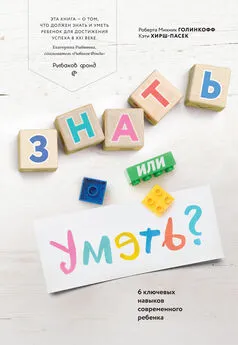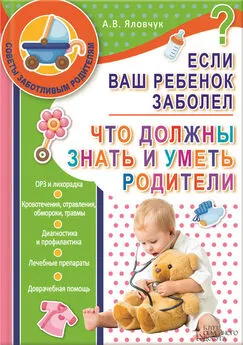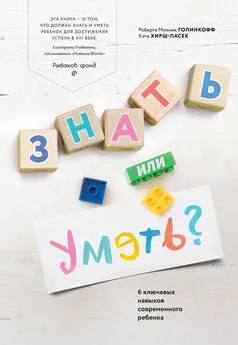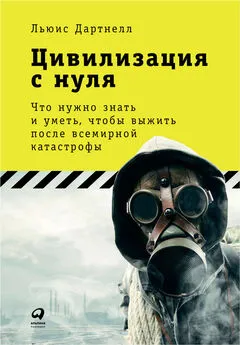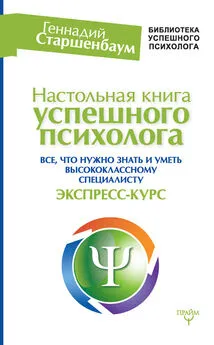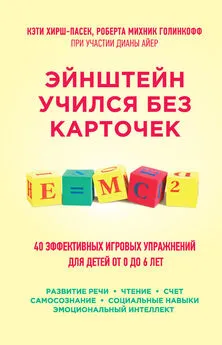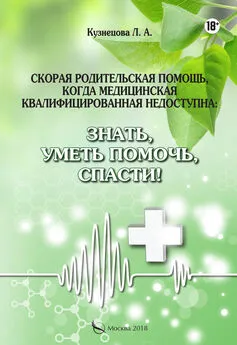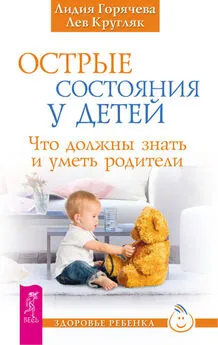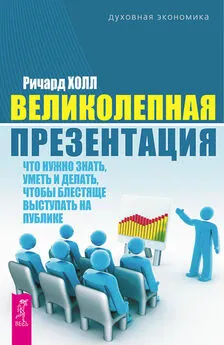Роберта Голинкофф - Знать или уметь?
- Название:Знать или уметь?
- Автор:
- Жанр:
- Издательство:Манн, Иванов и Фербер
- Год:2018
- Город:Москва
- ISBN:978-5-00100-981-8
- Рейтинг:
- Избранное:Добавить в избранное
-
Отзывы:
-
Ваша оценка:
Роберта Голинкофф - Знать или уметь? краткое содержание
Знать или уметь? - читать онлайн бесплатно ознакомительный отрывок
Интервал:
Закладка:
199
Rohn, J. (9 февраля 2012). [Facebook post]. См. здесь: www.facebook.com/OfficialJimRohn/posts/10151254021005635.
200
Golinkoff, R.M., Hirsh-Pasek, K., & Eyer, D. (2004). Einstein never used flashcards: How our children really learn — and why they need to play more and memorize less. New York, NY: Rodale Books, с. 79.
201
Garrison, M.M., & Christakis, D.A. (декабрь 2005). A teacher in the living room? Educational media for babies, toddlers, and preschoolers. Menlo Park, CA: Henry J. Kaiser Family Foundation.
202
FCAT (Florida Comprehensive Assessment Test) — Всесторонний оценочный тест штата Флорида.
203
Great Schools Staff. (n.d.). The Florida Comprehensive Assessment Test and State Standards: An overview. См. здесь: www.greatschools.org/gk/articles/testing-in-florida-fcat/.
204
Клятва верности американскому флагу обычно каждое утро произносится в госучреждениях, а также в школах.
205
Понсе де Леон (1460–1521) — испанский конкистадор, который основал первое европейское поселение в Пуэрто-Рико и во время поисков источника вечной молодости в 1513 году «открыл» Флориду.
206
IBM Big Data Hub. (n.d.). The four V’s of big data. См. здесь: www.ibmbigdatahub.com/sites/default/files/infographic_file/4-Vs-of-big-data.jpg.
207
Plutarch. (1992). Essays by Plutarch (R. Waterfield, Trans.). London, England: Penguin Classics, с. 50.
208
Устройства для оплаты проезда по платному шоссе в США, заменившие во многих местах кассиров и кассы.
209
Hammonds, B. (2009). Quotes from Frank Smith and John Taylor Gatto. См. здесь: http://leading-learning.blogspot.ru/2009/05/quotes-from-frank-smith-and-john-taylor.html, абзац 2.
210
Craik, F.I., & Lockhart, R.S. (1972). Levels of processing: A framework for memory research. Journal of Verbal Learning & Verbal Behavior, 11, 671–684. https://doi.org/10.1016/S0022-5371(72)80001-X.
211
Слово «продромальный» употребляется для описания первых симптомов, говорящих о начале приступа или заболевания. При шизофрении продромальная фаза подразумевает социальную изоляцию, тревогу.
212
Markoff, J. (25 июля 2009). Scientists worry machines may outsmart man. The New York Times. См. здесь: www.nytimes.com/2009/07/26/science/26robot.html, абзац 8.
213
Turkle, S. (2011). Alone together: Why we expect more from technology and less from each other. New York, NY: Basic Books, с. 12.
214
National Center on Education and the Economy. (2007). Tough choices or tough times: The report of the Commission on the Skills of the American Workforce. San Francisco, CA: Jossey-Bass, с. 50.
215
Это парафраз высказывания Дарвина, якобы из его книги «Происхождение видов». Упоминается здесь: Megginson, L.C. (1963). Lessons from Europe for American business, Southwestern Social Science Quarterly, 44, 3–13, с. 4.
216
James, W. (1890). The principles of psychology. New York, NY: Henry Holt & Company. dx.doi.org/10.1037/11059-000, с. 462.
217
Golinkoff, R.M., Hirsh-Pasek, K. (1999). How babies talk: The magic and mystery of language in the first three years of life. New York, NY: Dutton.
218
Saffran, J.R., Aslin, R.N., Newport, E.L. (1996). Statistical learning by 8-month-old infants. Science, 274, 1926–1928. dx.doi.org/10.1126/science.274.5294.1926.
219
McElroy, M. (30 октября 2013). A first step in learning by imitation, baby brains respond to another’s actions. University of Washington: UW Today. См. здесь: www.washington.edu/news/2013/10/30/a-first-step-in-learning-by-imitation-baby-brains-respond-to-anothers-actions/, абзац 4.
220
Bortfeld, H., Morgan, J.L., Golinkoff, R.M., & Rathbun, K. (2005). Mommy and me: Familiar names help launch babies into speech-stream segmentation. Psychological Science, 16, 298–304. dx.doi.org/10.1111/j.0956–7976.2005.01531.x.
221
Gopnik, A., Meltzoff, A. N., Kuhl, P.K. (2000). The scientist in the crib: What early learning tells us about the mind. New York, NY: William Morrow Paperbacks.
222
Chi, M.T.H. (2013). Learning from observing experts. (J.J. Staszewski (Ed.), Expertise and skill acquisition: The impact of William G. Chase [сс. 1–28]. New York, NY: Psychology Press.)
223
NoDoz — здесь имеется в виду таблетированный энергетический (ненаркотический) стимулятор.
224
Trebesh, L. (29 декабря 2011). Admitting you’re wrong: Getting it right in business. Взято с сайта Better Business Bureau: www.bbb.org/blog/2011/12/admitting-youre-wrong-getting-it-right-in-business/.
225
Hsu, S.S., & Glasser, S.B. (6 сентября 2005). FEMA director singled out by response critics. Washington Post, с. A1.
226
Hatton, S. (27 декабря 2011). Stella the dinosaur expert [видеофайл]. См. здесь: www.youtube.com/watch?v=jM4nomPWQ88.
227
Chi, M.T., Koeske, R.D. (1983). Network representation of a child’s dinosaur knowledge. Developmental Psychology, 19, 29–39. dx.doi.org/10.1037/0012–1649.19.1.29.
228
Pranava. (16 декабря 2012). Re: Child correcting other children and adults — What to do? [Комментарий на форуме]. См. здесь: www.mothering.com/forum/370-parenting-gifted-child/1370335-child-correcting-other-children-adults-what-do.html, абзац 1.
229
Blewitt, P., Golinkoff, R.M., Alioto, A. (2000). Do toddlers have label preferences? A possible explanation for word refusals. First Language, 20, 253–272.
230
Keil, F. (1996). Concepts, kinds, and cognitive development. Cambridge, MA: MIT Press.
231
Gelman, S.A., & Markman, E.M. (1985). Implicit contrast in adjectives vs. nouns: Implications for word-learning in preschoolers. Journal of Child Language, 12, 125–143. dx.doi.org/10.1017/S0305000900006279.
232
Gentner, D. (1983). Structure mapping: A theoretical framework for analogy. Cognitive Science, 7, 155–170. http://dx.doi.org/10.1207/s15516709cog0702_3.
233
Gentner, D., & Toupin, C. (1986). Systematicity and surface similarity in the development of analogy. Cognitive Science, 10, 277–300. dx.doi.org/10.1207/s15516709cog1003_2.
234
Oakes, L.M., Rakison, D.H. (2003). Issues in the early development of concepts and categories: An introduction. In D.H. Rakison & L.M. Oakes (Eds.), Early category and concept development: Making sense of the blooming, buzzing confusion (сс. 3–23). New York, NY: Oxford University Press. http://dx.doi.org/10.1207/s15327078in0701_7.
235
Gentner, D., & Toupin, C. (1986). Systematicity and surface similarity in the development of analogy. Cognitive Science, 10, 277–300. dx.doi.org/10.1207/s15516709cog1003_2.
236
В оригинале — sweet (буквально — «сладкая»).
237
Asch, S.E., & Nerlove, H. (1960). The development of double function terms in children: An exploratory investigation. In B. Kaplan & S. Wapner (Eds.), Perspectives in psychological theory (pp. 47–60). New York, NY: International Universities Press.
238
На английском языке «влюбляться» звучит как fall in love (буквально — «падать в любовь»).
239
Darling-Hammond, L. (21 мая 2007). Evaluating “No Child Left Behind.” The Nation. См. здесь: www.thenation.com/article/evaluating-no-child-left-behind/, абзац 11.
240
Venugopal Ramaswamy, S. (2 апреля 2015). State tests: Stakes are even higher for teachers. Lohud. См. здесь: www.lohud.com/story/news/local/2015/04/01/teachers-face-penalty-poor-student-performance/70798718/.
241
Shavelson, R.J., Linn, R.L., Baker, E.L., Ladd, L.F., Darling-Hammond, L., Shepard, L.A., Barton, Rothstein, R. (27 августа 2010). Problems with the use of student test scores to evaluate teachers. Economic Policy Institute. См. здесь: www.epi.org/publication/bp278/, абзац 6.
242
Parker-Poke, T. (24 февраля 2009). The 3 R’s? A fourth is crucial, too: Recess. The New York Times. См. здесь: www.nytimes.com/2009/02/24/health/24well.html.
243
Fausset, R., & Blinder, A. (14 апреля 2015). Atlanta school workers sentenced in test score cheating case. The New York Times. См. здесь: www.nytimes.com/2015/04/15/us/atlanta-school-workers-sentenced-in-test-score-cheating-case.html.
244
Perlstein, L. (2008). Tested: One American school struggles to make the grade. New York, NY: Holt Paperbacks.
245
Sullivan, M. (21 ноября 2011). Behind America’s tutor boom. MarketWatch. См. здесь: www.marketwatch.com/story/behind-americas-tutor-boom-1318016970246.
246
Sawyer, R.K. (Ed.). (2006). The Cambridge handbook of the learning sciences: Vol. 2., No. 5. New York, NY: Cambridge University Press.
247
Эта клятва — бессмысленный набор слов, созвучных настоящей клятве верности американскому флагу. Оригинальный текст звучит так: I pledge allegiance to the flag of the United States of America, and to the republic, for which it stands, one nation under God. Indivisible, with liberty and justice for all. Ребенок же запомнил: I pledge allegiance to the frog of the United States of America and to the wee public for witches hands one Asian, under God, in the vestibule with little tea and just rice for all.
248
Oliver, H., & Utermohlen, R. (1995). An innovative teaching strategy: Using critical thinking to give students a guide to the future. Holly Springs, MS: Rust College.
249
Dunlosky, J., Rawson, K.A., March, E.J., Nathan, M.J., Willingham, D.T. (2013). Improving students’ learning with effective learning techniques: Promising directions from cognitive and educational psychology. Psychological Science in the Public Interest, 14, 4–58.
Читать дальшеИнтервал:
Закладка:
